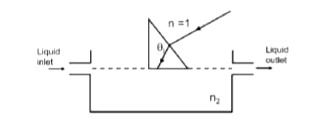Prove that μ=1sinC' where C is the critical angle.
Step by step video & image solution for Prove that mu = (1)/(sin C)' where C is the critical angle. by Physics experts to help you in doubts & scoring excellent marks in Class 12 exams.
Topper's Solved these Questions
- BOOK - PRADEEPCHAPTER - OPTICSEXERCISE - Very short answer question5videos
OPTICS
- BOOK - PRADEEPCHAPTER - OPTICSEXERCISE - very short answer questions1videos
OPTICS
- BOOK - PRADEEPCHAPTER - MAGNETIC EFFECT OF CURRENT AND MAGNETISMEXERCISE - Competition Focus (Multiple Choice Questions)2videos
MAGNETIC EFFECT OF CURRENT AND MAGNETISM
Similar Questions
Knowledge Check
- Question 1 - Select One
The velocity of light through media 'A' and 'B' are V and 2V, respectively. The value of sin C is ______ [where 'C' is the critical angle].
A12B13C3D2 - Question 2 - Select One
Critical angle of glass is θ1 and that of water is θ2. The critical angle for water and glass surface would be (μg=3/2,μw=4/3)
Abetween θ1andθ2.Bgreater than θ2Cless than θ1Dless than θ2 - Question 3 - Select One
Critical angle of glass is θ1 and that of water is θ2. The critical angle for water and glass surface would be (μg=3/2,μw=4/3)
Aless than θ2Bbetween θ1 and θ2Cgreater than θ2Dless than θ1
A right - angled isoceles prism is held on the surface of a liquid composed of miscible solvents A and B of refractive index nA=1.50andnB=1.30 respectively . The refractive index of prism is np=1.5 and that of the liquid is given by NL=CAnA+(1−CA)nB where CA is the percentage of solventA in the liquid

IF θC is the critical angle at prism - liquid interface . the plot which best represents the variation of the critical angle with the percentage of solvent isView SolutionIn ΔABC , prove that tanA+tanB+tanC≥3√3,whereA,B,C are acute angles.
View SolutionA right - angled isoceles prism is held on the surface of a liquid composed of miscible solvents A and B of refractive index nA=1.50andnB=1.30 respectively . The refractive index of prism is np=1.5 and that of the liquid is given by NL=CAnA+(1−CA)nB where CA is the percentage of solventA in the liquid

IF θC is the critical angle at prism - liquid interface . the plot which best represents the variation of the critical angle with the percentage of solvent isView SolutionFind the angle of refraction in a medium (μ=2) if light is incident in vacuum, making an angle equal to twice the critical angle.
View SolutionA, B and C are three optical media of respective critical angles C1, C2 and C3. Total internal reflection of light can occur from A and B and also from B to C but not from C to A. Then the correct relation between critical angles is
View Solution
